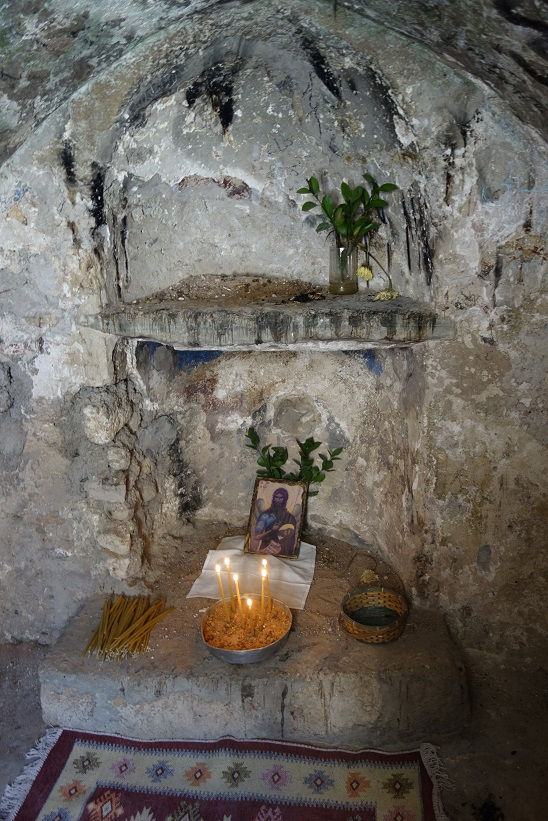ORTHODOX HOLY LAND
In the middle of the present village, in the area that was probably just outside the wall in the eastern side of the Roman city, a maqam (sanctuary) built inside the shell of a Crusader cathedral recalls the place where Muslims and Christians honoured the tomb of Saidna Yahia/St. John the Baptist. From Christian sources, we learn that during 4th century AD, the tradition began about the remains of John the Baptist being buried in Sebastia, next to prophets Elisha and Obadiah’s tombs.
According to the Gospels and the Koran, the Roman ruler Herod Antipas (the son of Herod the Great) had imprisoned the prophet Yahya/St. John because he was reproaching him for the adulterous relations with Herodias, the wife of his brother Herod Philip I. At a party for Herod’s birthday, Herodias’s daughter Salome danced before the king and his guests. Her dancing pleased Herod so much that he promised to give her anything she desired. Herodias suggested Salome to ask for the head of the prophet. The Gospels continue the narration, writing that after his death his disciples took the Baptist’s body and buried it.
The Baptist’s tomb was located for the first time in Sebastia by Rufinus from Aquileia, who lived in Jerusalem on the Mount of Olives, who describes the pagan reaction against the Christians in 361-362 under the reign of Emperor Julian the Apostate, when the remains of John the Baptist were taken from the tomb and burnt, then the ashes dispersed. However, some of the remains were rescued by passing monks from the monastery of deacon Philip of Jerusalem.
“At the times of Emperor Julian [...] in Sebastia, city of Palestine, the pagans invaded John the Baptist’s sepulchre: they first dispersed his bones, but then they collected them again to burn them; they mixed the sacred ashes with dust and dispersed them all in the countryside and villages. But for God’s will, some monks came along from Philip’s monastery in Jerusalem ... they mixed up with those who where collecting the bones to burn, they collected some too with carefulness and pious devotion, at the best of their ability, and they went away stealthily bringing the venerable remains to the saint Father Philip” (Hist. Eccles. VII, 4)
In Bethlehem around the year 390, St. Jerome, while translating in Latin the Onomasticon of the Holy Sites written between the end of the III and the beginning of the IV century by the Greek Eusebius, Bishop of Caesarea, adds about Samaria/Sebastia: “where the remains of John the Baptist are guarded”. The same author recalls the tomb of St. John in Sebastia in his account of St. Paula’s pilgrimage to the Holy Sites. The Palestinian monk John Rufus, bishop of Majuma in Gaza, is the first to recall a church, around 512, built on the Baptist’s tomb in Sebastia: “This site, in fact, was a particular chapel of the church, enclosed within gates because it contains two urns covered in gold and silver, in front of which burn perennial lamps: one is John the Baptist’s, the other is Prophet Elisha’s.” (Plerophoriae, PO 8, 70).
The pilgrim Theodoric (1169-72) wrote that part of the relics were displayed in the church itself, but he is the first to describe the flight of steps going down the crypt. “Moreover, a piece of his arms is held there in great veneration. He was buried, however, in the crypt between the prophets Elisha and Obadiah, ….. One enters it down thirty-five steps” . Starting from today’s floor level, in the third bay of the central nave, under two bitter orange trees, a small dome gives access to a narrow staircase leading to the Roman tomb. The tomb is composed of a barrel-vaulted chamber and six sepulchral niches arranged in two rows on the southern wall. In the lower row, Christian tradition tells us the tomb of John the Baptist rests, between the prophets Elisha and Obadiah, while local narrative recalls also the tomb of his mother and his father Zacharia. The floor in opus sectile dates back probably to the Byzantine period (Bagatti), but the current arrangement of the tomb dates back to the Crusader period.
11 And his head was brought on a platter and given to the girl, and she brought it to her mother. 12 Then his disciples came and took away the body and buried it, and went and told Jesus. Matthew 14:11-12
Link to google maps (Be sure to print maps if travelling to the site as the roads are not found on GPS): HERE
Click photo to see larger image and longer description:
ST JOHN THE FORERUNNER BEHEADING - SEBASTIA





Follow pathway on the left by foot and go up the hill.

Continue the pathway until you find the ruins of the church.


The location of the Beheading is located in the dark room down the stairs on the left.



Located in the stairwell going to the room.

Located in the stairwell going to the room.
